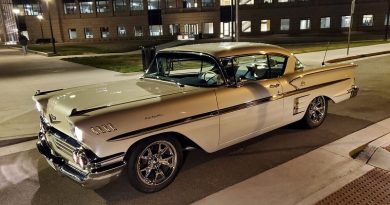1935 Talbot-Lago T120 Cabriolet Figoni & Falaschi
France automakers struggled through difficult economical conditions during the early 1930s with few surviving. One of the French survivors was Darracq/Talbot that was purchased by Italian Major Anthony F. ‘Tony’ Lago in 1934 from the Sunbeam-Talbot-Darracq (STD) Company. The STD Company had a strong reputation for performance, superior engineering, and durability – a reputation that Lago would attempt to uphold. The sale included the facilities located in Suresnes, France and the rights to use the Darracq and Talbot names. The cars sold in France were known as Talbots while the UK products were dubbed Darracqs. Engineer and ex-Fiat employee Walter Becchia was tasked to create a new line of six-cylinder engines.


The T120 was a Talbot-Lago staple from 1935 to the outbreak of World War II in 1939, and it reflected Major Antony Lago’s emphasis on stylish performance. Its box-section frame was robust, and its 3.0-litre overhead-valve inline six engine, developed by Walter Becchia from a design patented in 1934, was advanced for the day and was the predecessor to the famous T150C engine.

The Talbot Lago cars featured Figoni designed and patented coachwork, built by Figoni. Under agreement, the Figoni designs could be used the following year on production models, built by the Talbot Lago factory. These factory-built examples would vary slightly from the Figoni-bodied examples; the factory-bodied cars were void of running boards that connected the wings in the front and rear together.

The Talbot Lago T120 in this gallery, chassis 85.221, was built in 1935 and bodied by Figoni, the same year the coachbuilder teamed up with Italian businessman Ovidio Falaschi to form the firm Figoni et Falaschi. It was delivered new to the Var department of south-eastern France to one G. Stanislas of Toulon. It is said this car was not bodied by the factory. The coachwork order for this car came from Talbot in late 1934 for 21,000 Francs, a very large sum of money in those days. The coachwork is gracefully executed, with a stunning shade of yellow and a lovely Lalique mascot sitting atop the radiator.

The car was sold in 1937 to one André “L” in nearby Bouches-du-Rhone. The next record of the car appears in 1947 after the cessation of World War II. André now lived in Marseilles, and it is quite likely the car survived the war, stored away in a private garage. The car had been transformed substantially in the intervening years. The radiator, front wings and wheels had all been changed. Figoni’s signature is still visible on the doors, and while the design is reminiscent of his work, the coachbuilder that conducted the modifications is presently unknown.




